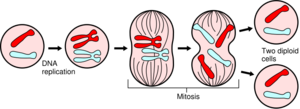Mitosis
Prophase, Anaphase, CytokinesisMetaphase, Telophase

Mitosis is a process that sorts and evenly distributes a cell's genetic instructions to the nuclei of two daughter cells during cell division. Mitosis distributes identical DNA instructions to new cells when the old cell divides.
Growth is based on cell division and mitosis. Some cells in the body—such as nerve and skeletal muscle cells—cannot divide, and they stay with us for life. But most tissues of the body grow and replace themselves by cell division. These cells go through a cell cycle from the time they are formed until the time when they divide. During the period of mitosis, the nucleus and cytoplasm divide to form two new cells. The rest of the cell cycle is known as interphase.
In the nucleus of a cell, DNA comprises a code carrying all the instructions that the cell needs to live. In the nuclei of eukaryotic cells, the DNA molecules, coiled like microscopic spaghetti, form compact, bulky structures called chromosomes. Under the light microscope, chromosomes have the appearance of solid, flexible rods. Early microscopists applied the word chromosome, meaning "colored body," to structures that took up basic red or purple dyes in the nucleus of a dividing cell. Humans have 23 chromosomes, but other organisms, like the fruit fly, have as few as four, and others, such as the dog, as many as 39.
As chromosomes uncoil at the beginning of interphase, the thin threads of DNA, termed chromatin, become invisible to an observer looking through a light microscope. Each chromosome then makes a copy of itself, stringing together basic units available in the cytoplasm according to its own sequence. Now two identical DNA strands, called sister chromatids, are attached to each other by a structure known as a centromere. The DNA begins to twist and coil, curling more and more tightly.
At this point, the cell begins to assemble the scaffolding it needs for moving the chromosomes to opposite ends of the cell. In animal cells, the two centrioles—small cylinders containing tiny tubular elements—replicate. The cells of higher plants do not have centrioles.
Mitosis is a continuous process, but for convenience, scientists divide it into four stages: prophase, metaphase, anaphase, and telophase.
In the second stage of mitosis, called metaphase, the pairs of sister chromatids line up in the center of the cell like couples taking their place on a dance floor. The centromeres of the chromosomes appear to be aligned within an imaginary plate midway between the centrioles and dissecting the cell at right angles to the spindle. Responding to some unknown cue, the centromeres divide in unison, freeing the sister chromatids to separate in the next phase.
During telophase, or the "clean-up" stage of mitosis, the spindle apparatus is broken down, and the tubulin subunits stand ready to form the cytoskeleton of a new cell. The chromosomes, now clustered in two groups around the poles, uncoil into tangled threads again, and a new nuclear envelope forms around them. At this point, each new nucleus contains one copy of each chromosome. Mitosis is complete.
Additional topics
Science EncyclopediaScience & Philosophy: Methane to Molecular clock